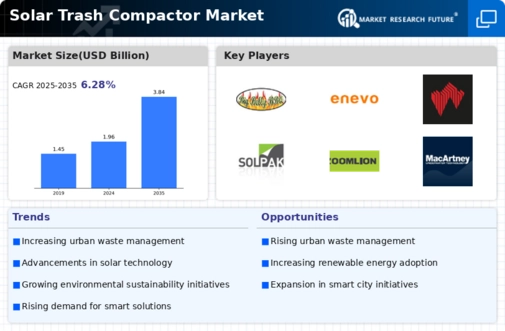Growing Urbanization
The rapid pace of urbanization globally is a key driver for the Global Solar Trash Compactor Market Industry. As cities expand, the volume of waste generated increases significantly, necessitating efficient waste management solutions. Solar trash compactors, which utilize renewable energy to compress waste, are becoming increasingly attractive to municipalities. For instance, urban areas are projected to account for approximately 68 percent of the global population by 2050. This trend indicates a growing demand for innovative waste management technologies, with the market expected to reach 1.96 USD Billion in 2024, reflecting the urgent need for sustainable solutions in urban environments.
Market Growth Projections
The Global Solar Trash Compactor Market Industry is projected to experience substantial growth over the coming years. With an estimated market value of 1.96 USD Billion in 2024, the industry is expected to expand significantly, reaching 3.84 USD Billion by 2035. This growth trajectory suggests a robust compound annual growth rate (CAGR) of 6.3% from 2025 to 2035. Such projections indicate a strong market potential driven by factors such as urbanization, technological advancements, and increasing environmental awareness. The anticipated growth underscores the importance of solar trash compactors in modern waste management strategies.
Technological Advancements
Technological advancements play a pivotal role in the Global Solar Trash Compactor Market Industry. Innovations in solar energy capture and waste compaction technology enhance the efficiency and effectiveness of these systems. For instance, the integration of IoT technology allows for real-time monitoring of waste levels, optimizing collection routes and schedules. This not only reduces operational costs but also improves service delivery. As cities increasingly adopt smart waste management solutions, the demand for advanced solar trash compactors is likely to rise, further driving market growth and contributing to the overall sustainability of urban waste management.
Government Regulations and Incentives
Government regulations and incentives significantly influence the Global Solar Trash Compactor Market Industry. Many countries are implementing stricter waste management regulations, encouraging municipalities to adopt innovative solutions like solar trash compactors. Incentives such as grants, tax breaks, and subsidies for renewable energy projects further stimulate market growth. For example, several regions offer financial support for cities transitioning to solar-powered waste management systems. This regulatory environment fosters an increase in the adoption of solar trash compactors, as municipalities seek to comply with regulations while also benefiting from cost savings and improved waste management efficiency.
Environmental Sustainability Initiatives
The Global Solar Trash Compactor Market Industry is propelled by increasing environmental sustainability initiatives worldwide. Governments and organizations are prioritizing eco-friendly waste management practices to reduce landfill waste and carbon emissions. Solar trash compactors, which operate on renewable energy, align with these sustainability goals. For example, cities implementing these compactors report reductions in waste collection frequency and associated emissions. The market is anticipated to grow at a CAGR of 6.3% from 2025 to 2035, potentially reaching 3.84 USD Billion by 2035, as more municipalities adopt sustainable waste management technologies.
Public Awareness and Demand for Clean Cities
Public awareness regarding waste management and the demand for cleaner urban environments are driving factors in the Global Solar Trash Compactor Market Industry. As communities become more conscious of environmental issues, there is a growing expectation for local governments to implement effective waste management solutions. Solar trash compactors, which reduce litter and enhance the cleanliness of public spaces, are increasingly favored by citizens. This shift in public sentiment encourages municipalities to invest in solar compactors, thereby contributing to the market's expansion. The rising demand for cleaner cities is likely to sustain the growth of the solar trash compactor market in the coming years.


















Leave a Comment